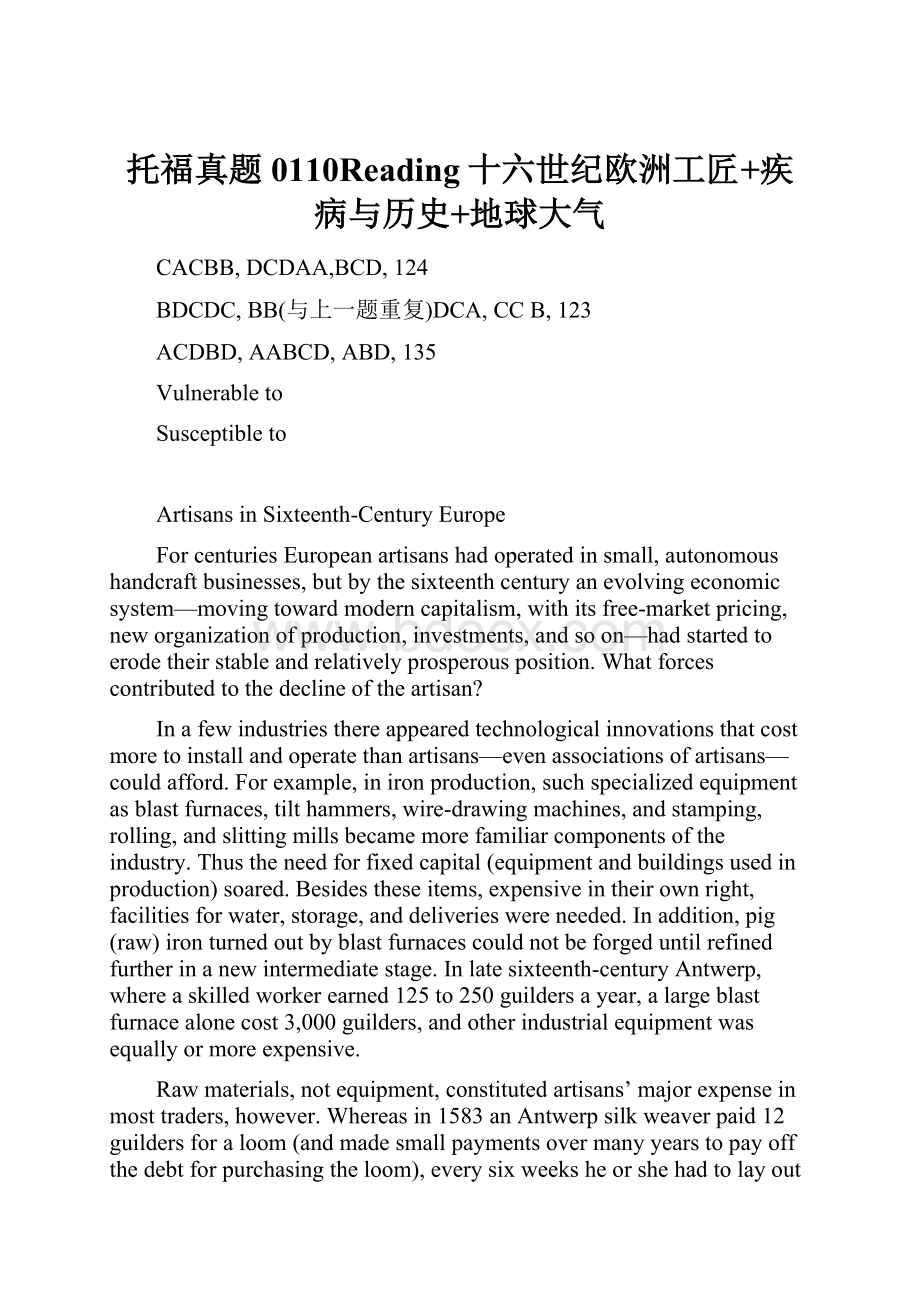托福真题0110Reading十六世纪欧洲工匠+疾病与历史+地球大气.docx
《托福真题0110Reading十六世纪欧洲工匠+疾病与历史+地球大气.docx》由会员分享,可在线阅读,更多相关《托福真题0110Reading十六世纪欧洲工匠+疾病与历史+地球大气.docx(26页珍藏版)》请在冰豆网上搜索。

托福真题0110Reading十六世纪欧洲工匠+疾病与历史+地球大气
CACBB,DCDAA,BCD,124
BDCDC,BB(与上一题重复)DCA,CCB,123
ACDBD,AABCD,ABD,135
Vulnerableto
Susceptibleto
ArtisansinSixteenth-CenturyEurope
ForcenturiesEuropeanartisanshadoperatedinsmall,autonomoushandcraftbusinesses,butbythesixteenthcenturyanevolvingeconomicsystem—movingtowardmoderncapitalism,withitsfree-marketpricing,neworganizationofproduction,investments,andsoon—hadstartedtoerodetheirstableandrelativelyprosperousposition.Whatforcescontributedtothedeclineoftheartisan?
Inafewindustriesthereappearedtechnologicalinnovationsthatcostmoretoinstallandoperatethanartisans—evenassociationsofartisans—couldafford.Forexample,inironproduction,suchspecializedequipmentasblastfurnaces,tilthammers,wire-drawingmachines,andstamping,rolling,andslittingmillsbecamemorefamiliarcomponentsoftheindustry.Thustheneedforfixedcapital(equipmentandbuildingsusedinproduction)soared.Besidestheseitems,expensiveintheirownright,facilitiesforwater,storage,anddeliverieswereneeded.Inaddition,pig(raw)ironturnedoutbyblastfurnacescouldnotbeforgeduntilrefinedfurtherinanewintermediatestage.Inlatesixteenth-centuryAntwerp,whereaskilledworkerearned125to250guildersayear,alargeblastfurnacealonecost3,000guilders,andotherindustrialequipmentwasequallyormoreexpensive.
Rawmaterials,notequipment,constitutedartisans’majorexpenseinmosttraders,however.Whereasin1583anAntwerpsilkweaverpaid12guildersforaloom(andmadesmallpaymentsovermanyyearstopayoffthedebtforpurchasingtheloom),everysixweeksheorshehadtolayout24guildersforthe2poundsofrawsilkrequiredtomakeapieceofcloth.Thusaccesstocheapandplentifulprimarymaterialswasaconstantpreoccupationforindependentproducers.Usinglocalmaterialsmightalloweventhepoorestamongthemtoavoidrelianceonmerchantsuppliers.Thelossofnearbysourcescouldthereforebedevastating.AssilkcultivationwanedaroundtheSpanishcitiesofCordobaandToledo,weaversinthesecitieswereforcedtobecomeemployeesofmerchantswhoputoutrawsilkfromValenciaandMurciaprovinces.IntheDutchRepublic,merchantswhoimportedunprocessedsaltfromFrance,Portugal,andSpaingainedcontrolofthesalt-refiningindustryonceexploitationoflocalsaltmarsheswashaltedforfearthatdikes(whichheldbacktheseafromthelow-lyingDutchland)wouldbeundermined.
Creditwasnecessaryforproductionbutcreatedadditionalvulnerabilitiesforartisans.Pricesforindustrialproductslaggedbehindthoseofrawmaterialsandfoodstuffs,andthis,coupledwithrisingtaxes,madeitdifficultformanyproducerstorepaytheircreditors.Periodicdownturns,whenfoodpricesshotupanddemandformanufacturesfelloff,drovethemfurtherintodebtorevenintobankruptcy,fromwhichtheymightemergeonlybyagreeingtoselltheirproductsexclusivelytomerchantsorfellowartisanswhoextendedthemloans.Frequentenoughduringperiodsofgrowth,suchcreditcrisesbecamedeeperandlastedlongerafterabout1570,asdidwar-relateddisruptionsofraw-materialsuppliesandmarkets.
Artisans’autonomywasimperiled,too,byrestrictionsontheiraccesstomarkets.Duringthesixteenthcentury,asituationlikethisoftenresultedfromtheconcentrationofexporttradeinafewgreatstorageanddistributioncenters.ThedisappearanceofregionalmarketswhereweaversinFlanders(whatisnownorthernBelgium)hadpreviouslyboughtflaxandsoldlinenleftthematthemercyofbig-citymiddlemen,whoquicklyturnedthemintodomesticworkers.Inasimilarfashion,formerlyindependentproducersinsouthernWiltshireinEngland,whohadboughtyarnfromspinnersorlocalbrokersandsoldtheirclothtomerchantsinnearbySalisbury,becamesubjecttoLondonmerchantswhomonopolizedbothwoolsuppliesandwoolensexports.
Withgoodreason,finally,urbanartisansfearedthegrowthofindustriesinthecountryside.Foronething,theyworriedthatthespreadofvillagecraftswouldreducetheirsupplyofrawmaterials,drivingupprices.Cityproducersalsoknewthatrurallocationsenjoyedlowerlivingcosts,wages,andtaxes,andoftenemployedfewerorsimplifiedprocesses.Theseadvantagesbecameamajorpreoccupationascompetitionintensifiedinthe1570sand1580s
Paragraph1
ForcenturiesEuropeanartisanshadoperatedinsmall,autonomoushandcraftbusinesses,butbythesixteenthcenturyanevolvingeconomicsystem—movingtowardmoderncapitalism,withitsfree-marketpricing,neworganizationofproduction,investments,andsoon—hadstartedtoerodetheirstableandrelativelyprosperousposition.Whatforcescontributedtothedeclineoftheartisan?
1.Whichofthesentencesbelowbestexpressestheessentialinformationinthehighlightedsentenceinthepassage?
Incorrectchoiceschangethemeaninginimportantwaysorleaveoutessentialinformation.C(句子主干)
¡Inthesixteenthcentury,theEuropeaneconomymovedtowardasystemoffree-marketpricing,newwaysofproduction,andinvestments.
¡Beforethesixteenthcentury,Europeanmakersofhandcraftsenjoyedstability,autonomy,andrelativeprosperity.
¡Bythesixteenthcentury,theriseofcapitalismbegantoweakentheautonomyandrelativeprosperityofEuropeanartisans.
¡Europeanartisansoperatedsmall,autonomousbusinessesbeforemoderncapitalismemergedinthesixteenthcentury.
Paragraph2
Inafewindustriesthereappearedtechnologicalinnovationsthatcostmoretoinstallandoperatethanartisans—evenassociationsofartisans—couldafford.Forexample,inironproduction,suchspecializedequipmentasblastfurnaces,tilthammers,wire-drawingmachines,andstamping,rolling,andslittingmillsbecamemorefamiliarcomponentsoftheindustry.Thustheneedforfixedcapital(equipmentandbuildingsusedinproduction)soared.Besidestheseitems,expensiveintheirownright,facilitiesforwater,storage,anddeliverieswereneeded.Inaddition,pig(raw)ironturnedoutbyblastfurnacescouldnotbeforgeduntilrefinedfurtherinanewintermediatestage.Inlatesixteenth-centuryAntwerp,whereaskilledworkerearned125to250guildersayear,alargeblastfurnacealonecost3,000guilders,andotherindustrialequipmentwasequallyormoreexpensive.
2.Theword“Besides”inthepassageisclosetinmeaningtoA
¡Inadditionto
¡Moreimportantthan
¡Differentfrom
¡Togetherwith
3.Accordingtoparagraph2,howdidtechnologicaladvancescontributetotheeconomicdeclineofartisans?
¡Artisanshadnoplacetostoreorusethenewmachines.
¡Goodsproducedbythenewtechnologywerecheaperthanthoseproducedbyartisans.
¡Thefixedcostsofremaininginbusinessbecameveryhigh.
¡Artisansdidnotknowhowtousethenewmachines.
Paragraph3
Rawmaterials,notequipment,constitutedartisans’majorexpenseinmosttraders,however.Whereasin1583anAntwerpsilkweaverpaid12guildersforaloom(andmadesmallpaymentsovermanyyearstopayoffthedebtforpurchasingtheloom),everysixweeksheorshehadtolayout24guildersforthe2poundsofrawsilkrequiredtomakeapieceofcloth.Thusaccesstocheapandplentifulprimarymaterialswasaconstantpreoccupationforindependentproducers.Usinglocalmaterialsmightalloweventhepoorestamongthemtoavoidrelianceonmerchantsuppliers.Thelossofnearbysourcescouldthereforebedevastating.AssilkcultivationwanedaroundtheSpanishcitiesofCordobaandToledo,weaversinthesecitieswereforcedtobecomeemployeesofmerchantswhoputoutrawsilkfromValenciaandMurciaprovinces.IntheDutchRepublic,merchantswhoimportedunprocessedsaltfromFrance,Portugal,andSpaingainedcontrolofthesalt-refiningindustryonceexploitationoflocalsaltmarsheswashaltedforfearthatdikes(whichheldbacktheseafromthelow-lyingDutchland)wouldbeundermined.
4.Theword“preoccupation”inthepassageisclosetinmeaningto
¡necessity
¡concern
¡struggle
¡uncertainty
5.Inparagraph3,whydoestheauthorprovidetheinformationaboutanAntwerpsilkweaver’scostsin1583?
¡Todescribesometypicalcostsinthesilk-weavingindustry
¡Tosupportthestatementthatartisans’mainexpensewasmaterials,notequipment
¡Toargueagainsttheviewthatartisansdidnothavetoborrowmoneytobuyequipment
¡Toshowthatmaterialswerecheapandplentifulformostartisans
6.Whatcanbeinferredfromparagraph3aboutlocalmaterials?
¡Theywereofhigherqualitythanimportedmaterials.
¡Theywereusuallymoreplentifulthanimportedmaterials.
¡Theyremainedavailableevenaftermerchantsbegantocontroltheindustries.
¡Theytendedtobemoreaffordablethanmaterialssuppliedbymerchants.
7.Accordingtoparagraph3,whichofthefollowingwassometimesaneffectonartisansofthelossoflocalsourcesoftheirprimarymaterials?
¡Theyhadtoselltheirproductstomerchants.
¡Theyneededtotakeloansinordertobuythematerialsfrommerchants.
¡Theycouldnolongeraffordtobeindependentproducers.
¡Theyimportedthematerialsfromdistantsources.
Paragraph4
Creditwasnecessaryforproductionbutcreatedadditionalvulnerabilitiesforartisans.Pricesforindustrialproductslaggedbehindthoseofrawmaterialsandfoodstuffs,andthis,coupledwithrisingtaxes,madeitdifficultformanyproducerstorepaytheircreditors.Periodicdownturns,whenfoodpricesshotupanddemandformanufacturesfelloff,drovethemfurtherintodebtorevenintobankruptcy,fromwhichtheymightemergeonlybyagreeingtoselltheirproductsexclusivelytomerchantsorfellowartisans